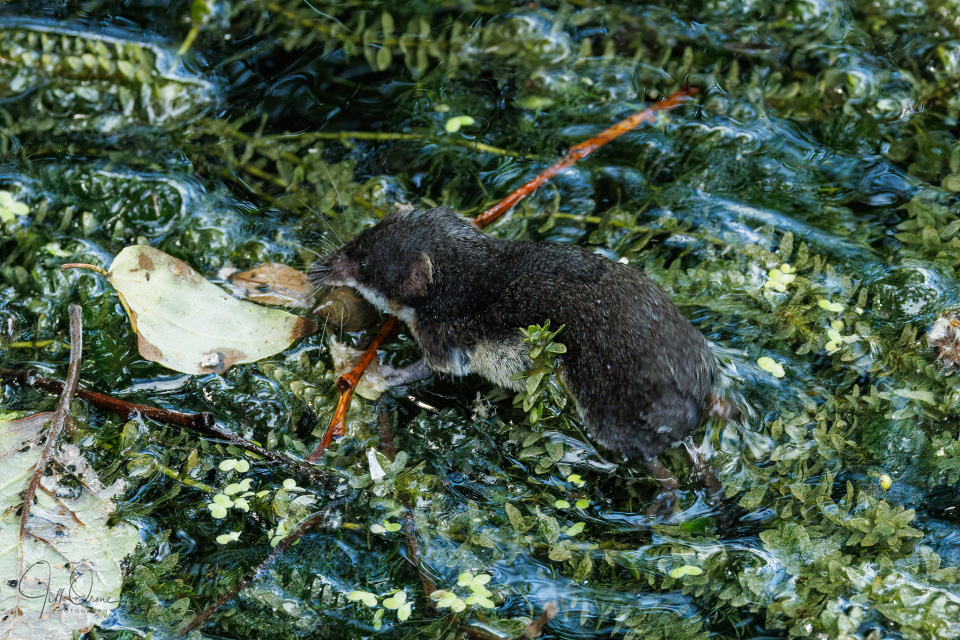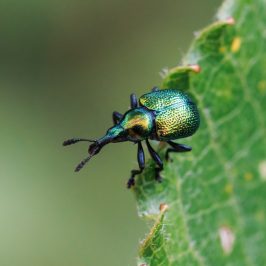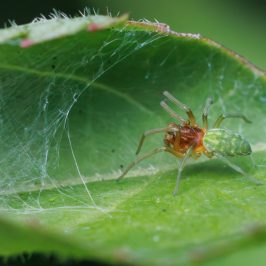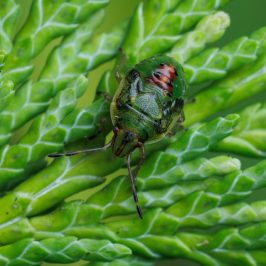When I arrived home this afternoon and told R that I’d just spent forty five minutes trying to photograph something that wasn’t a dragonfly, he looked understandably bemused and asked me what it was. “I don’t actually know,” I said. “It looked like a shrew, but it was big – at least the size of a hamster – and it was swimming. Are aquatic shrews a thing?”
It turns out that Water Shrews are indeed a thing, and they’re not even rare, though I’m probably not alone among you in never having seen one before because they’re shy, and having extremely poor eyesight they can hunt as easily at night as during the day. They’re also highly unsociable and territorial, much like myself, though in the summer months only the females hold territories, while the males wander in search of receptive females. This one was working the darkest corner of the Big Pond at Cleeve Prior Community Orchard, making it hard to spot and even harder to photograph – an excuse I offer by way of apology for the obvious deficiencies of this shot.
Water Shrews live for between one and three years, usually in wetland sites or along the banks of ponds, steams and ditches. They dig extensive burrow systems, and line them with soft vegetation. My guesstimate that this one (which I assume is a female) was about the size of a domestic hamster wasn’t too far out, provided you count the tail: hamsters average 18cm in length, whereas the Water Shrew is 6-9cm long, with a tail length of 5-8cm.Their litters can stretch to fifteen young, though six to eight is more usual; gestation lasts for about three and a half weeks, and the female feeds her offspring for about seven weeks, after which they become fully independent and quit the mother’s territory, leaving her potentially free to breed again.
Having a high metabolic rate, Water Shrews need to feed almost constantly – this one darted out of a hole in the pond wall every couple of minutes and dived under the water, emerging a few seconds later with some kind of prey item and carrying it back to her burrow. I couldn’t always see what she was holding, but in this case, despite the motion blur, you can see that it was an aquatic snail. They are superb swimmers, with stiff hairs on their feet and the undersides of their tails which help with paddling and steering, and they can dive up to a metre, even though there’s an insulating layer of air trapped between their skin and their fur which makes them very buoyant. If necessary they can use their tails as Harvest Mice do, wrapping them around vegetation to keep them underwater long enough to catch a prey item.
The teeth of Water Shrews store iron to keep them strong, and are alleged to be red-tipped because of this, though in the photos I’ve seen they look more orange. Interestingly, they have venomous saliva, which is sufficiently strong to immobilise a small fish or amphibian, though it wouldn’t pose a danger to humans. And as well as being good on the attack, Water Shrews are pretty effective at defence: they can secrete a foul-smelling oil that makes them extremely unappetising to predators such as owls and foxes.
One final bonus fun fact, if you’ve managed to stay with me this long: although they look like rodents, shrews are actually members of the order Eulipotyphla, which translates as “truly fat and blind”. This means that they’re far more closely related to hedgehogs and moles than they are to rats and mice.
R: C4.







